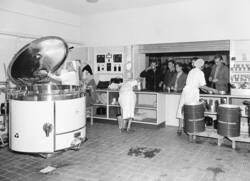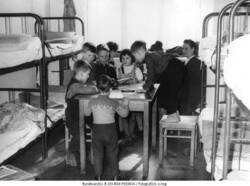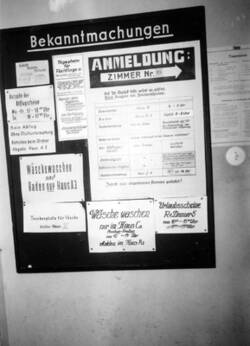Further Media
You are in the right place if you can see a building with a large window through the fence.
This building used to be the reception center's dining hall and is now used for events, including by the Marienfelde Refugee Center Museum. The historical photo in the guide shows the front of the building, with people waiting for their lunch.
As the accommodation for refugees is not open to the public - like the reception center previously – we can not go inside. However, if you step closer to the fence, you should be able to see the path along side where the hall is located.
All the center’s community facilities were located along the path, such as the washroom, bathrooms, clothing store, baggage room, and storage room for bedding, towels, and tableware; these were provided to refugees for everyday use during their stay. The offices of numerous information centers and welfare organizations were also located here.
Life in the reception center was strictly regulated. While it was a relief for many refugees to have accommodation, meals, and a fixed schedule, especially in the first days, it also meant a lot of stress due to the confined and cramped conditions. Waiting in line for hours, sharing bedrooms with strangers at night, and inevitable aggression and conflicts among the residents were common.
In the mid-1970s, the reception center's operation was gradually modernized in response to growing criticism. Bunk beds, fixed mealtimes, security patrols, and the "lights out" rule were phased out. A telephone booth in the camp, a television in the lounge, and refrigerators in the apartments were installed. Visiting hours were also extended.
Several more changes followed: In 1989, the bunk beds were temporarily brought back due to the enormous increase in residents. A playground was built, three apartments were converted to be barrier-free, and some blocks were renovated. However, after 70 years of permanent use, the center has yet to be completely refurbished.




